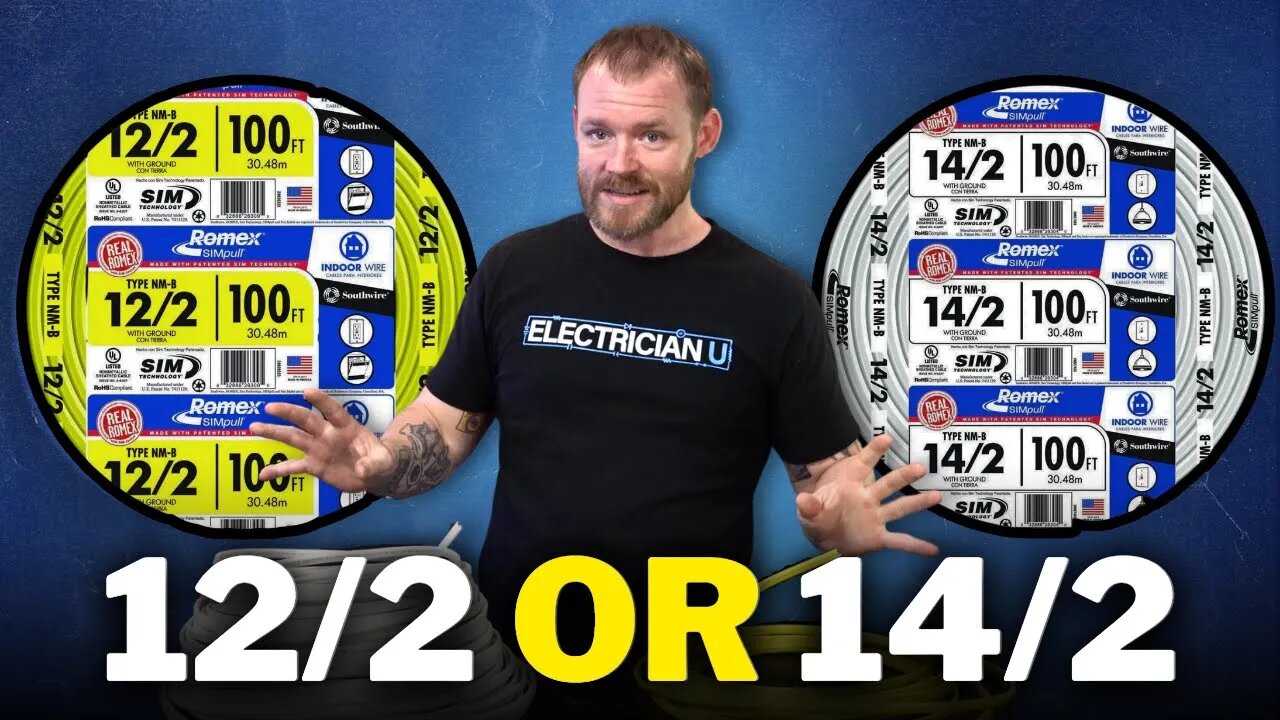Premium Only Content

Should You Be ONLY Using 12/2? When Can You Use 14/2?
Join this channel to get access to perks:
https://www.youtube.com/channel/UCB3jUEyCLRbCw7QED0vnXYg/join
When it comes to using NM cable to wire a house, there are 2 general camps that contractors fall into. Those that wire the house in 14/2 and those that will wire the house entirely in 12/2. But which is the correct way to do it? In today’s episode of Electrician U, Dustin dives into this topic and gives us some explanations and tips on doing it correctly.
🤘⚡️MEMBERSHIP⚡️🤘
JOIN ELECTRICIAN U - become a member and get:
FREE Continuing Education every year
FREE Practice Exams
FREE Monthly Video Courses
FREE Weekly Live Instructor-Led Classes
FREE Monthly Educational Newsletter
Premium Members-Only Content
Private Discord Channel
Monthly Members-Only Discord Chats
Sign up here --- https://www.electricianu.com/electrician-u-membership/
🎧🎹MUSIC AND VIDEO:🎹🎧
https://www.facebook.com/descantmv
🎬✍️ART AND ILLUSTRATION:✍️🎬
https://www.daverussoart.com
So, the initial response to this question is to check with your Local AHJ (electrical inspector) to find out their requirements and the requirements of the jurisdiction you are working in. The inspector will have the final say of what they are willing to inspect. The current electrical code (2023 NEC is the most recent, however, many jurisdictions are still using the 2020 NEC) is also a resource to be referenced. Articles 240.4, 210.21 and 310.16 are great articles governing circuitry and wire sizing. Something to keep in mind is that type NM cable falls under the 60-degree rating, and not the 75-degree rating used in most commercial wiring.
The next, and most practical, explanation of what to use to wire a house would be the circuitry type itself. In recent discussions on Electrician U, we have covered Series wiring and Parallel wiring. From those discussions, we have deduced that (for amperage) on a series circuit, amperage is the total of ALL the loads, and that amperage is throughout the entire circuit. This is because we must travel THROUGH one load to get to the next load. But, on a parallel circuit, the amperage is in direct relation to the resistance of the particular load within each leg, and the combined amperage of everything that is on the entire circuit is only on the conductors that are feeding. This is where we will focus on some options we have (again, depending on what our local AHJ will accept).
LED lighting draws considerably less amperage than its incandescent/fluorescent counterparts. So, while installing 12/2 NM cable from the panel throughout the power portion of the circuit, once we leave the load side of the switch, that can be run in 14/2 since amperage draw is less. Consider this circuit- let’s say we have a parallel circuit with one receptacle feeding a 5a load, a second circuit feeding an 8a load, a light switch that was controlling 4 LED can lights at 1a, and a 3rd receptacle at the end completing our circuit. With the first 5a load running, the amperage draw would be 5a from the breaker through our load. Once we started our second 8a load, the conductors around that load would be drawing 8a but where they enter the circuit conductors “feeding” the other loads, the amperage draw is 13a. If we added the 4 can lights, those feeding conductors are drawing 14a now, but those on the load side of the switch are only drawing 1a! So, as long as the local AHJ accepts it, many contractors will run 12/2 conductors throughout the receptacle circuit and up to the line side of the switch, and swap over to 14/2 for the load side of the switch throughout the lighting portion. Over the course of a large home (or many smaller homes added together), the cost/labor savings can be substantial!
We hope this has been helpful in deciding which wire (14/2 or 12/2) to use when wiring a house. Is there a topic you would like to see discussed on Electrician U. Is there a topic you would like to see discussed? Please leave us a comment in the comments section and let us know. Please continue to follow Dustin Stelzer and Electrician U as we are constantly updating our content to assist our followers in becoming the best electricians that they can be.
-
 0:56
0:56
Electrician U
1 year ago90° Drill Attachment!!! - What Hand Tools Are YOU Missing
5.49K1 -
 1:08:16
1:08:16
Tactical Advisor
18 hours agoNEW Budget Glocks | Vault Room Live Stream 011
116K9 -
 16:30
16:30
SNEAKO
1 day agoNO FRIENDS IN THE INDUSTRY.
153K68 -
 6:19
6:19
BlackDiamondGunsandGear
1 day agoHow Fat Guys can Appendix Carry
107K12 -
 6:58
6:58
Gun Owners Of America
1 day ago2024 Was Huge For Gun Rights, Here's Our Top 10 Wins!
86.1K8 -
 15:50
15:50
Degenerate Jay
1 day ago $3.18 earnedJames Bond Is Being Ruined By Amazon? Make Him A Black Gay Woman?
65.8K15 -
 15:18
15:18
DeVory Darkins
1 day ago $26.70 earnedTrump Drops NIGHTMARE Warning on Joe Biden
80.6K117 -
 36:13
36:13
The Why Files
1 month agoAlien Implants Vol. 1: Devil’s Den UFO Encounter: What Was Found Inside Terry Lovelace?
82.9K44 -
 9:03
9:03
Alabama Arsenal
2 days ago $1.14 earnedAAC HUB 2K | Modern Features, Iconic Classic Looks
28.7K1 -
 13:49
13:49
Dermatologist Dr. Dustin Portela
2 days ago $1.57 earnedDermatologist Reveals the Worst Things To Do To Your Skin
21.4K14